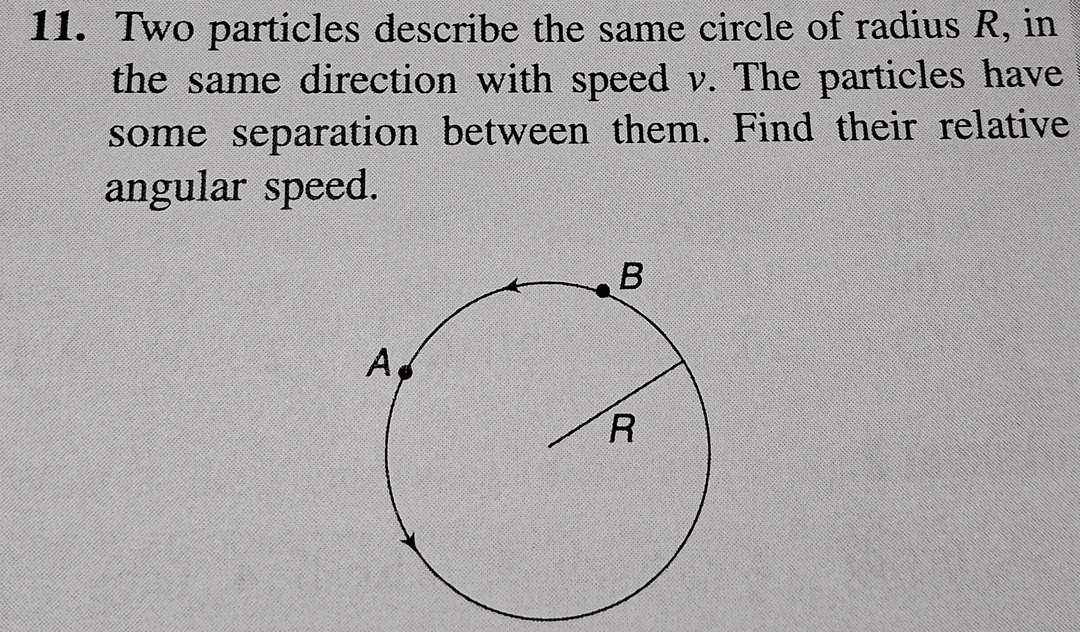Question
Question: Two particles describe the same circle of radius R, in the same direction with speed v. The particle...
Two particles describe the same circle of radius R, in the same direction with speed v. The particles have some separation between them. Find their relative angular speed.

\frac{v}{R}
Solution
The problem asks for the relative angular speed of two particles describing the same circle of radius R, in the same direction, with the same speed v.
Let's denote the two particles as P1 and P2. The angular speed of each particle with respect to the center of the circle is given by ω=Rv. Since both particles have the same speed v and are on the same circle of radius R, their individual angular speeds are identical: ω1=Rv ω2=Rv
When two particles are moving with the same angular speed in the same direction on the same circular path, their angular separation remains constant. This means that if you draw a line connecting the center of the circle to each particle, the angle between these two lines does not change over time.
Therefore, the rate of change of the angular separation between them is zero. The relative angular speed of particle 2 with respect to particle 1 (or vice versa), when both are observed from the center of the circle, is: ωrel=ω2−ω1=Rv−Rv=0.
However, sometimes "relative angular speed" can refer to the angular speed of one particle as seen from the other particle, where the other particle is considered as a moving origin. Let's analyze this interpretation, as suggested by the similar question's solution.
Let the center of the circle be the origin O. Let particle 1 be at position r1 and particle 2 at r2. Their velocities are v1 and v2. Since they are moving in the same direction with the same speed v on the same circle, we have ∣v1∣=∣v2∣=v. Also, the angular speed of each particle about the center is ω=v/R.
The relative velocity of particle 2 with respect to particle 1 is v21=v2−v1. The relative position vector of particle 2 with respect to particle 1 is r21=r2−r1.
The angular velocity of particle 2 with respect to particle 1 is given by the formula: ω21=∣r21∣2r21×v21
Let's set up a coordinate system. Let particle 1 be at (R,0) at some instant. So, r1=Ri^. Assuming counter-clockwise motion, its velocity is v1=vj^. Let particle 2 be at an angular position θ ahead of particle 1. So, r2=Rcosθi^+Rsinθj^. Its velocity is v2=−vsinθi^+vcosθj^.
Now, calculate the relative vectors: r21=r2−r1=(Rcosθ−R)i^+Rsinθj^=R(cosθ−1)i^+Rsinθj^ v21=v2−v1=−vsinθi^+(vcosθ−v)j^=−vsinθi^+v(cosθ−1)j^
Next, calculate the cross product r21×v21: r21×v21=i^R(cosθ−1)−vsinθj^Rsinθv(cosθ−1)k^00 =k^[R(cosθ−1)⋅v(cosθ−1)−Rsinθ⋅(−vsinθ)] =k^[Rv(cosθ−1)2+Rvsin2θ] =k^Rv[cos2θ−2cosθ+1+sin2θ] =k^Rv[1+1−2cosθ] =k^Rv[2−2cosθ] Using the identity 1−cosθ=2sin2(2θ), we have 2−2cosθ=4sin2(2θ). So, r21×v21=k^Rv[4sin2(2θ)]
Now, calculate the square of the magnitude of r21: ∣r21∣2=(R(cosθ−1))2+(Rsinθ)2 =R2(cosθ−1)2+R2sin2θ =R2(cos2θ−2cosθ+1+sin2θ) =R2(1+1−2cosθ) =R2(2−2cosθ) =R2(4sin2(2θ))
Finally, the magnitude of the relative angular velocity: ∣ω21∣=∣r21∣2∣r21×v21∣=R2[4sin2(2θ)]Rv[4sin2(2θ)] =Rv
This result means that the angular speed of particle 2 as observed from particle 1 (or vice versa) is equal to the individual angular speed of each particle about the center of the circle. This is a common result for particles moving in the same direction with the same speed on the same circle.
The relative angular speed is Rv.
Explanation of the solution:
Two particles on the same circle of radius R moving in the same direction with the same speed v have individual angular speeds ω=v/R. The relative angular speed of one particle with respect to the other, calculated using the formula ωrel=∣rrel∣2rrel×vrel, is found to be Rv.
